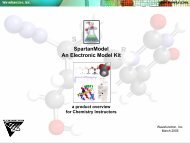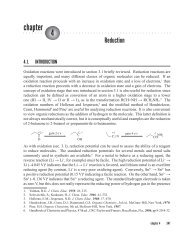Molecular Modeling in Chemical Education and ... - Wavefunction, Inc.
Molecular Modeling in Chemical Education and ... - Wavefunction, Inc.
Molecular Modeling in Chemical Education and ... - Wavefunction, Inc.
Create successful ePaper yourself
Turn your PDF publications into a flip-book with our unique Google optimized e-Paper software.
<strong>Molecular</strong> <strong>Model<strong>in</strong>g</strong> <strong>in</strong><br />
<strong>Chemical</strong> <strong>Education</strong> <strong>and</strong> Research<br />
Summer Tour 2005<br />
Professor Richard Johnson<br />
Chemistry Department<br />
University of New Hampshire<br />
rpj@cisunix.unh.edu<br />
Sean Ohl<strong>in</strong>ger<br />
<strong>Wavefunction</strong>, <strong>Inc</strong>.<br />
18401 Von Karman, Suite 370<br />
Irv<strong>in</strong>e, CA 92612<br />
sean@wavefun.com<br />
www.wavefun.com
What are we go<strong>in</strong>g to do today?<br />
• Introduce you to molecular model<strong>in</strong>g <strong>and</strong> some of<br />
its many applications <strong>in</strong> teach<strong>in</strong>g <strong>and</strong> research.<br />
• Introduce the newest versions of Spartan as tools <strong>in</strong> teach<strong>in</strong>g.<br />
• Introduce Odyssey, a new program for dynamic models.<br />
• Demonstrate the Cambridge Crystal Structure Database<br />
(CCSD) <strong>and</strong> its <strong>in</strong>terface with Spartan.<br />
• Give you plenty of time to have fun.<br />
• Exchange ideas
What we won’t do today!<br />
1. Overwhelm you.<br />
2. Teach you the <strong>in</strong>tricacies of Spartan <strong>and</strong> Odyssey.<br />
3. Present the details of computational chemistry.
The Essential Elements<br />
• Fast computers are now readily available. Today’s Pentium or PowerMac laptop is<br />
much faster than yesterday’s ma<strong>in</strong>frame computer.<br />
• Sophisticated computational models are based on quantum mechanics <strong>and</strong> classical<br />
mechanics.<br />
• Recent development of the graphical user <strong>in</strong>terface permits rapid construction of<br />
models <strong>and</strong> spectacular visualization of the results. This has made molecular<br />
model<strong>in</strong>g accessible to anyone.
Some th<strong>in</strong>gs we often forget.....<br />
• chemistry is about molecules<br />
• molecules are three dimensional<br />
• we can’t solve the Schröd<strong>in</strong>ger equation exactly for<br />
molecules but the approximate solutions are excellent
Sir John Pople 1925-2004<br />
"I could have done it <strong>in</strong> a much more<br />
complicated way," said the red Queen,<br />
immensely proud.<br />
- Lewis Carroll<br />
“The essence of John Pople . . . to take<br />
what is, or what seems to be, <strong>in</strong>tractable<br />
<strong>and</strong> make it so, so simple. Thank you,<br />
s<strong>in</strong>cerely thank you, for shar<strong>in</strong>g your<br />
precious gift with me, <strong>and</strong> with the<br />
scientific world. You will be sorely<br />
missed.”<br />
Warren Hehre, President/CEO,<br />
<strong>Wavefunction</strong>, <strong>Inc</strong>.
Essentials of <strong>Model<strong>in</strong>g</strong><br />
Build Structures: Many programs are just visualizers. Spartan allows<br />
the rapid construction of virtually any structure <strong>in</strong> three dimensions.<br />
Odyssey allows you to build your own molecular dynamics simulations.<br />
Perform Computations: Force-field <strong>and</strong> quantum mechanical models<br />
offer sophisticated descriptions of molecules, both known <strong>and</strong><br />
unknown. We can’t solve the Schröd<strong>in</strong>ger equation exactly for<br />
molecules but the approximate solutions are excellent.<br />
Visualize <strong>and</strong> Interpret Results: Results <strong>in</strong>clude structure, energies,<br />
molecular orbitals, electron densities, vibrational modes, dynamics<br />
simulations, etc.<br />
Recycle: Each answer often will lead to more questions <strong>and</strong> new<br />
calculations.
Applications of molecular<br />
model<strong>in</strong>g <strong>and</strong> visualization<br />
•Research <strong>in</strong> <strong>in</strong>dustry <strong>and</strong> academics.<br />
•Design of new pharmaceuticals.<br />
•College graduate level coursework.<br />
•College undergraduate coursework.<br />
•On the worldwide web!<br />
•Even <strong>in</strong> high school classrooms.
What can I do with model<strong>in</strong>g <strong>and</strong> visualization<br />
<strong>in</strong> my classroom <strong>and</strong> laboratory?<br />
•Enhance teach<strong>in</strong>g of selected concepts <strong>and</strong> content.<br />
•Emphasize the molecular nature of chemistry.<br />
•Move from two dimensions <strong>in</strong>to three.<br />
•Show real 3 dimensional dynamic models – not just movies.<br />
•Prepare course material <strong>and</strong> WWW images.<br />
•Computational experiments <strong>in</strong> place of selected wet labs.<br />
•Motivate students to be excited about chemistry.<br />
•Research, enrichment <strong>and</strong> special projects.<br />
•Advanced courses.<br />
•Better prepare students for graduate school <strong>and</strong> future<br />
careers <strong>in</strong> chemistry.
What can I do with model<strong>in</strong>g <strong>and</strong><br />
visualization <strong>in</strong> my research?<br />
•Build <strong>and</strong> visualize complex structures <strong>in</strong> three dimensions.<br />
•Import/export structures from/to other sources or projects.<br />
•Use computations to model structure, conformation,<br />
energetics, thermodynamics <strong>and</strong> chemical reactivity.<br />
•Predict spectral properties: IR, UV-VIS, NMR shifts<br />
•Predict new chemical reactions.<br />
•Build <strong>and</strong> ma<strong>in</strong>ta<strong>in</strong> a library of structures.<br />
•Prepare images for presentations, web pages, publications<br />
<strong>and</strong> proposals.<br />
•Enhance my own professional tra<strong>in</strong><strong>in</strong>g <strong>and</strong> credentials.<br />
•Enhance my underst<strong>and</strong><strong>in</strong>g of the literature.
Current <strong>Wavefunction</strong> Software<br />
SpartanModel<br />
an electronic model kit<br />
Spartan ST<br />
Student Edition<br />
Spartan ’04<br />
’06 is on the way….
What is<br />
?<br />
A New Set of Programs + Associated<br />
Chemistry Content<br />
for Teach<strong>in</strong>g Concepts <strong>in</strong><br />
Introductory Chemistry<br />
Odyssey is set to an accurate molecular scale<br />
with time <strong>and</strong> molecular size greatly exp<strong>and</strong>ed.
An Introduction to Spartan
Spartan Architecture<br />
Density<br />
Functional<br />
Semi-Empirical<br />
<strong>Molecular</strong> Orbital<br />
Ab Initio<br />
<strong>Molecular</strong> orbital<br />
Graphical<br />
User<br />
Interface<br />
<strong>Molecular</strong><br />
Mechanics<br />
External<br />
Graphical<br />
Surfaces<br />
Properties
Build<strong>in</strong>g <strong>and</strong> Visualiz<strong>in</strong>g Structures:<br />
<strong>Chemical</strong> evolution from methane to DNA
Current <strong>Wavefunction</strong> Software<br />
SpartanModel<br />
Spartan ST Student Edition<br />
Spartan Essential<br />
Spartan ’04<br />
’06 is on the way….
Now that we know how to build<br />
molecules, it’s time for bit of theory……
Theoretical Models<br />
Methods Based on Quantum Mechanics: These are approximate Solutions to<br />
the Schrod<strong>in</strong>ger equation<br />
•Semi–empirical :(CNDO, MNDO, ZINDO, AM1, PM3 etc.): based on the<br />
Hartree-Fock self-consistent field (HF-SCF) method, valence electrons only,<br />
approximations greatly simplify calculations, parameterized to fit experimental<br />
results; recent extension to many transition metals.<br />
•Ab Initio: (Non–empirical; from “first pr<strong>in</strong>ciples”): also HF-SCF but <strong>in</strong>cludes all<br />
electrons <strong>and</strong> uses m<strong>in</strong>imal approximation, large collection of methods <strong>and</strong> levels<br />
of theory; <strong>in</strong>crease <strong>in</strong> complexity for both basis functions <strong>and</strong> electron correlation.<br />
•Density Functional: Based on electron density; <strong>in</strong>cludes electron correlation.<br />
Methods Based on Classical Mechanics<br />
•Force Field Methods: (MM2, MMFF, Amber, Sybyl, UFF etc.): based on<br />
Hooke's law, van der Waals <strong>in</strong>teractions, electrostatics etc.; parameterized to fit<br />
experimental data. Also used to create dynamic models <strong>in</strong> Odyssey.
Schrod<strong>in</strong>ger Equation<br />
Nuclei don't move<br />
Electronic Schrod<strong>in</strong>ger equation<br />
Guess how electrons affect<br />
each other from idealized problem<br />
1. Electrons move <strong>in</strong>dependently<br />
2. <strong>Molecular</strong> "solutions" written<br />
<strong>in</strong> terms of atomic solutions<br />
Hartree-Fock<br />
<strong>Molecular</strong> orbital methods<br />
parameterization<br />
AB INITIO<br />
HARTREE-FOCK<br />
MODELS<br />
Mix <strong>in</strong> excited states<br />
to account for<br />
electron correlation<br />
1. Atomic orbitals don't<br />
<strong>in</strong>teract.<br />
2. Parameterization<br />
DENSITY<br />
FUNCTIONAL<br />
MODELS<br />
CONFIGURATION<br />
INTERACTION<br />
AND MOLLER-<br />
PLESSET MODELS<br />
SEMIEMPIRICAL<br />
MO MODELS
Basis Sets for Computational Models<br />
Semiempirical Methods: use Slater-type<br />
functions; one size fits all<br />
Ab Initio methods: most commonly used are Gaussian<br />
functions; comb<strong>in</strong>ation of Gaussians gives Slater-type<br />
orbitals.<br />
<strong>Inc</strong>reas<strong>in</strong>g Complexity<br />
M<strong>in</strong>imal basis set STO-3G<br />
Split-Valence or Double-Zeta 3-21G(*)<br />
Polarized basis sets 6-31G*<br />
Extended basis sets 6-311+G**<br />
Hartree-Fock limit: <strong>in</strong>f<strong>in</strong>ite basis set<br />
unreliable<br />
energetics<br />
for most<br />
accurate<br />
calculations<br />
excellent<br />
results
Correlation energy: Electrons correlate their motion better than Hartree-Fock<br />
theory allows for. This is typically a small portion of the total energy. <strong>Inc</strong>lusion<br />
of electron correlation lowers the energy of the wavefunction.<br />
Hartree Fock<br />
Energy<br />
Correlation<br />
Energy<br />
Exact<br />
Energy<br />
Example: Methane Basis Set 6-311G*<br />
Energy RelativeEnergy<br />
(hartrees) (kcal/mol)<br />
----------------------------------------------------------------------<br />
E Hartree Fock -40.202409 0.0 kcal/mol<br />
EMP2 -40.349308 -92.1<br />
EMP3 -40.365949 -102.6<br />
EMP4SDQ -40.369786 -105.0<br />
EMP4 -40.372940 -107.0<br />
B3LYP -40.527982 -204.2<br />
When do you really need electron correlation?<br />
Important for the most accurate calculations.<br />
Essential for excited states, transition states, structures with<br />
unusual bond<strong>in</strong>g schemes, high-sp<strong>in</strong> molecules….
Which computational method do you need?<br />
<strong>Inc</strong>reas<strong>in</strong>g level of theory<br />
Correlated methods<br />
(DFT, MP etc.<br />
Ab Initio Hartree Fock<br />
(3-21G, 6-31G* etc)<br />
Semiempirical<br />
(AM1, MNDO, PM3)<br />
Force-Field<br />
(MMF, Syby)<br />
excited states, UV spectra, transition<br />
state energies, structures with unusual<br />
bond<strong>in</strong>g schemes, most accurate<br />
predictions of structure <strong>and</strong> properties<br />
more accurate prediction of structure<br />
<strong>and</strong> properties, NMR spectra, relative<br />
energies of isomers, qualitative description<br />
of transition states <strong>and</strong> reactions<br />
basic description of structure <strong>and</strong> bond<strong>in</strong>g,<br />
vibrational spectra,, start<strong>in</strong>g geometries for<br />
higher level calculations<br />
conformational analysis, start<strong>in</strong>g<br />
geometries for other calculations,<br />
basic questions of structure <strong>and</strong> shape
<strong>Model<strong>in</strong>g</strong> Carbohydrate Complexes at Multiple levels of Theory
Approximate relationship between molecular<br />
size <strong>and</strong> computational dem<strong>and</strong>s<br />
AB INITIO<br />
METHODS<br />
CPU <strong>and</strong> MEMORY DEMANDS<br />
SEMI-EMPIRICAL<br />
METHODS<br />
FORCE-FIELD<br />
METHODS<br />
MOLECULAR SIZE
Visualization
Vibrational Frequency Analysis<br />
Stationary po<strong>in</strong>ts on a potential surface are characterized by<br />
vibrational frequency analysis. Vibrational modes may be<br />
calculated <strong>and</strong> animated.<br />
Energy m<strong>in</strong>ima will have all positive vibrational modes.<br />
Energy maxima (first order transition states) will have a<br />
s<strong>in</strong>gle negative or imag<strong>in</strong>ary mode. This corresponds to<br />
the reaction coord<strong>in</strong>ate. Higher order transition states exist<br />
but they are rare. (L<strong>in</strong>ear water for example!)<br />
Calculated vibrational frequencies usually are ca. 10% too<br />
high relative to experiment.
What is the significance of this structure?
Back to work…….What can we calculate?<br />
Sample calculations on a simple molecule.<br />
• Optimized structure<br />
• Vibrational modes<br />
• Surfaces
Charge <strong>and</strong> Multiplicity<br />
s<strong>in</strong>glet doublet s<strong>in</strong>glet<br />
CH 3<br />
+<br />
CH 3 CH 3<br />
-
Electrostatic Potential Maps<br />
The electrostatic potential is the energy of<br />
<strong>in</strong>teraction of a po<strong>in</strong>t positive charge (an<br />
electrophile) with the nuclei <strong>and</strong> electrons of a<br />
molecule. As a three dimensional isosurface, this<br />
easily shows lone pairs. Hydraz<strong>in</strong>e is shown here.<br />
The electrostatic potential can be mapped onto<br />
the electron density surface by us<strong>in</strong>g color to<br />
represent the value of the potential. The<br />
result<strong>in</strong>g model displays molecular size <strong>and</strong><br />
shape (from the density map) <strong>and</strong> is colored to<br />
represent relative positive <strong>and</strong> negative regions<br />
of the surface. Colors toward red <strong>in</strong>dicate<br />
negative values of the ESP, while colors toward<br />
blue represent positive potential values. Sodium<br />
chloride is shown <strong>in</strong> this example.
Visualiz<strong>in</strong>g Biomolecules:<br />
Carboxypeptidase from a PDB File
Gett<strong>in</strong>g the word out….<br />
Images <strong>and</strong> structures are easily transferred to:<br />
• Powerpo<strong>in</strong>t presentations like this one<br />
• Word-process<strong>in</strong>g programs<br />
• JPEG files www pages<br />
• AVI animations<br />
• PDB files www pages <strong>and</strong> other programs<br />
• Browser plug<strong>in</strong>s like Chime (MDLI) offer<br />
structure visualization on <strong>and</strong> off the WWW.
This is cool, but<br />
is there a version<br />
for<br />
Mac<strong>in</strong>tosh?
What is<br />
?<br />
A New Set of<br />
Programs +<br />
Associated Chemistry Content<br />
for Teach<strong>in</strong>g Concepts <strong>in</strong><br />
Introductory Chemistry<br />
Run Odyssey
…<strong>in</strong> the Introductory/General<br />
Chemistry/High School Curriculum:<br />
• Thermochemistry<br />
.<br />
• Gases<br />
• Liquids/Solids/Intermolecular Forces<br />
• Solutions<br />
• K<strong>in</strong>etics<br />
• <strong>Chemical</strong> Thermodynamics
SPARTAN<br />
vs.<br />
Molecules / Small Clusters<br />
Energy M<strong>in</strong>imization<br />
(T = 0)<br />
Small Molecule Chemistry<br />
(Organic / Inorganic /<br />
Medic<strong>in</strong>al / Biological)<br />
Quantum Mechanics<br />
Eng<strong>in</strong>e<br />
Also:<br />
Bulk Matter<br />
Dynamics at Given<br />
Temperature<br />
Introductory / General /<br />
Physical Chemistry<br />
Classical<br />
<strong>Molecular</strong> Dynamics<br />
SImulation Eng<strong>in</strong>e<br />
Integrated (DHTML)<br />
Chemistry Content
…is <strong>in</strong>teractive:<br />
• Stop-’N-Go Dynamics<br />
• Sample Manipulation<br />
• Property Queries<br />
• Plott<strong>in</strong>g<br />
…all “on-the-fly”,<br />
<strong>in</strong>itiated <strong>and</strong> controlled<br />
by the student
<strong>Molecular</strong> Dynamics<br />
Simulation Eng<strong>in</strong>e:<br />
Newton:<br />
F = m • a<br />
dE (x 1 ,y 1 ,z 1 ,…)<br />
dx 1<br />
= m 1 •<br />
dv x1<br />
dt<br />
Run Odyssey
Customization:<br />
…annotate pages<br />
…change sample(s)<br />
…change text<br />
…even create your own page !<br />
Models can be created <strong>in</strong> Spartan <strong>and</strong> brought directly <strong>in</strong>to Odyssey<br />
to create new molecular dynamics simulations.
MD Simulations: Input<br />
1. Positions x 1 ,y 1 ,z 1 ,… but really output <strong>in</strong><br />
“equilibrium” situations<br />
2. Velocities v x1<br />
,v y1<br />
,v z1<br />
, … basically temperature !<br />
3. Force field force field:<br />
E (x 1 ,y 1 ,z 1 ,…)<br />
MMFF with extensions,<br />
~ sufficient for pedagogical purposes
MD Simulations: Output<br />
• Equilibrium structure<br />
• Hydrogen bonds<br />
• Spontaneous changes<br />
• Response to perturbations<br />
• Energetics / Thermodynamics<br />
• Particle trajectories<br />
• Diffusive behavior<br />
• Rotational motion<br />
…for the<br />
chosen<br />
temperature
Search<strong>in</strong>g the Cambridge<br />
Structure Database (CSD)<br />
<strong>Wavefunction</strong> is now responsible for distribution of the Cambridge<br />
Structural Database (CSD) System (on W<strong>in</strong>dows <strong>and</strong> Unix) to academic<br />
<strong>in</strong>stitutions <strong>in</strong> the United States.<br />
The CSD currently conta<strong>in</strong>s more than 280,000 published X-ray crystal<br />
structures for organic <strong>and</strong> organometallic compounds. About 20,000 new<br />
structures are added annually. New versions of the CSD are released every<br />
six months. The CSD System <strong>in</strong>cludes the ConQuest search software used to<br />
<strong>in</strong>terrogate all CSD <strong>in</strong>formation fields (bibliographic, chemical <strong>and</strong><br />
crystallographic), <strong>and</strong> also <strong>in</strong>cludes IsoStar, a knowledge-base of<br />
<strong>in</strong>termolecular <strong>in</strong>teractions <strong>and</strong> Mercury, a visualization <strong>and</strong> analysis<br />
program.<br />
Structure search<strong>in</strong>g can be done directly through<br />
Spartan <strong>and</strong> structures are easily imported.
Search<strong>in</strong>g the Cambridge Database
Search<strong>in</strong>g the Spartan Database
Applications of Spartan<br />
•Teach<strong>in</strong>g basic concepts: atomic orbitals,<br />
acidity, resonance, chemical bond<strong>in</strong>g<br />
•Us<strong>in</strong>g lists<br />
•Conformational analysis<br />
•Coord<strong>in</strong>ate driv<strong>in</strong>g<br />
•Transition state search<strong>in</strong>g<br />
•Visualiz<strong>in</strong>g reactions<br />
•Examples from <strong>in</strong>organic chemistry
Atomic Orbitals: The Bromide Ion HF/3-21G Results<br />
Atomic configuration: 1s 2 2s 2 2p 6 3s 2 3p 6 3d 10 4s 2 4p 6<br />
Atomic Orbital Energies<br />
eigenvalues: -486.69845 1s<br />
-64.66592 -57.85828 -57.85828 -57.85828 2s,2p<br />
-9.52913 -7.10100 -7.10100 -7.10100 3s,3p<br />
-2.83570 -2.83570 -2.83570 -2.83570 -2.8357 3d<br />
-0.63114 -0.08504 -0.08504 -0.08504 4s,4p
4p<br />
4s<br />
3d<br />
ENERGY<br />
3p<br />
3s<br />
2p<br />
2s<br />
1s
Acidity: Oxoacids of Halogens<br />
hypochlorous acid<br />
chlorous acid<br />
chloric acid<br />
perchloric acid<br />
(hypochlorite ion)<br />
(chlorite ion)<br />
(chlorate ion)<br />
(perchlorate ion)<br />
HClO ↔ H + + ClO -<br />
HClO 2 ↔ H + + ClO 2<br />
-<br />
HClO 3 ↔ H + + ClO 3<br />
-<br />
HClO 4 ↔ H + + ClO 4<br />
-<br />
K a = 3.0x10 -8<br />
K a = 1.0x10 -2<br />
K a = 1.6x10 1<br />
K a = 1x10 10<br />
(weak)<br />
(strong)
Ionic vs. Covalent Bond<strong>in</strong>g: Salt<br />
Calculate sodium chloride at the ab <strong>in</strong>itio HF/3-21G(*)<br />
level of theory.<br />
Visualize electron density, electrostatic potential maps<br />
And charges.
Plott<strong>in</strong>g Data: Constra<strong>in</strong>ts, Lists <strong>and</strong> Spreadsheets
Animat<strong>in</strong>g the Inversion Barrier <strong>in</strong> Ammonia
3D Plots may also be useful
Us<strong>in</strong>g Lists <strong>and</strong> Spreadsheets: Conformations of Cyclohexane<br />
Other examples: shapes, radicals, HX polarization, alkane series, forms of carbon<br />
benzene MO’s, covalent vs. ionic bond<strong>in</strong>g, ozonolysis energetics, polyene UV,<br />
benzene isomers, benzonitrile nitration, hydroboration
NMR Spectral Calculation<br />
Another example
Example: Conformations of Octane
Visualiz<strong>in</strong>g <strong>Chemical</strong> Reactions<br />
Locate the transition state<br />
Calculate the <strong>in</strong>tr<strong>in</strong>sic reaction coord<strong>in</strong>ate<br />
Animate the transition state “imag<strong>in</strong>ary” vibrational mode
Start<strong>in</strong>g anwhere <strong>in</strong><br />
this region of space<br />
will usually f<strong>in</strong>d the<br />
m<strong>in</strong>imum.<br />
To f<strong>in</strong>d a transition state<br />
you MUST start with a<br />
guessed geometry <strong>in</strong><br />
this region of space
Stationary po<strong>in</strong>t: a molecular geometry where all forces on atoms are zero<br />
(or m<strong>in</strong>imized to tolerances set <strong>in</strong> programs.)<br />
1) Energy m<strong>in</strong>imum: easy to f<strong>in</strong>d but there are often many conformations.<br />
Frequency analysis will give all positive vibrational frequencies.<br />
2) First order saddle po<strong>in</strong>t or transition state: more difficult to f<strong>in</strong>d because<br />
you must start with a guessed geometry that is close to the answer.<br />
Frequency analysis will give one “imag<strong>in</strong>ary” frequency which corresponds<br />
to the reaction coord<strong>in</strong>ate.<br />
3) Higher order saddle po<strong>in</strong>t: a transition state <strong>in</strong> more than one direction.<br />
Frequency analysis will give two or more imag<strong>in</strong>ary frequencies. Simplest<br />
example may be l<strong>in</strong>ear water.<br />
TRANSITION<br />
STATE<br />
ENERGY<br />
REACTANT<br />
PRODUCT<br />
REACTION COORDINATE
<strong>Model<strong>in</strong>g</strong> Transition States<br />
Diels-Alder TS Migratory <strong>in</strong>sertion <strong>in</strong> CH 3<br />
Mn(CO) 5
Strategies for F<strong>in</strong>d<strong>in</strong>g Transition State Structures<br />
If you can f<strong>in</strong>d one TS, you have them all.<br />
F<strong>in</strong>d the simplest TS for the reaction first; then build on the rest of your molecule<br />
<strong>and</strong> partially optimize with the important structural components frozen.<br />
To exam<strong>in</strong>e regio- <strong>and</strong> stereochemical issues, build as many copies as you need<br />
<strong>in</strong> a spreadsheet <strong>and</strong> optimize them all <strong>in</strong> one job. This is an extraord<strong>in</strong>arily<br />
powerful technique.
Strategies for F<strong>in</strong>d<strong>in</strong>g Transition State Structures<br />
Use bond lengths or other constra<strong>in</strong>ts to pre-optimize a guess.<br />
Bonds that are be<strong>in</strong>g broken or made usually are 20 – 50% longer <strong>in</strong><br />
transition state structures. Look at related structures for guidance. Data<br />
often are highly transferable from related TS structures.<br />
This is almost always MUCH easier to accomplish <strong>in</strong> Spartan.<br />
NC<br />
H<br />
C<br />
Cl<br />
2.126<br />
H<br />
TS bond C--H bond length is<br />
ca. 1.4 - 1.5 Angstroms<br />
Diels-Alder TS usually has<br />
C----C bond lengths of<br />
1.9 - 2.3 Angstroms<br />
H H<br />
2.397<br />
B3LYP/6-31G*<br />
S N 2 has pentacoord<strong>in</strong>ate<br />
carbon <strong>and</strong> two long bonds
Strategies for F<strong>in</strong>d<strong>in</strong>g Transition State Structures<br />
Use the transition state library <strong>in</strong> Spartan: draw arrows correspond<strong>in</strong>g to<br />
the mechanism. The library <strong>in</strong>cludes thous<strong>and</strong>s of transition states.<br />
H<strong>in</strong>ts:<br />
1) Draw arrows <strong>in</strong> a cont<strong>in</strong>uous direction<br />
2) Use the INSERT key to place several molecules on screen<br />
3) Some arrows are drawn bond to bond<br />
4) To draw arrows to a space, hold down the<br />
shift key <strong>and</strong> click on two atoms separat<strong>in</strong>g the new bond.<br />
5) You can beg<strong>in</strong> on either side of a reaction.
A Research Example: Synthesis of Panepophenanthr<strong>in</strong> (2003)<br />
O<br />
HO<br />
Me<br />
Me<br />
O<br />
OH<br />
O<br />
OH<br />
O<br />
H<br />
H<br />
HO<br />
O<br />
R<br />
R<br />
O<br />
Eight possible<br />
modes of<br />
cycloaddition<br />
X. Lei., R. P. Johnson <strong>and</strong> J. A. Porco Jr.<br />
Angew. Chem. Internat. Edit. 2003,42, 3913.<br />
R = C(OH)(CH 3 ) 2<br />
O<br />
Me<br />
OH<br />
Me<br />
Me Me O<br />
OH<br />
H O<br />
H<br />
OH<br />
OH<br />
O<br />
panepophenanthr<strong>in</strong><br />
O<br />
HO<br />
Me<br />
O<br />
Me<br />
Me<br />
H<br />
H<br />
OH<br />
OH<br />
OH<br />
Me<br />
O
Intr<strong>in</strong>sic Reaction Coord<strong>in</strong>ate (IRC) Searches<br />
An IRC calculation starts with the TS geometry <strong>and</strong> Hessian, then locates the<br />
m<strong>in</strong>ima connected to this TS. This beg<strong>in</strong>s by follow<strong>in</strong>g the “imag<strong>in</strong>ary”<br />
vibrational mode. IRC calculations are time consum<strong>in</strong>g s<strong>in</strong>ce each po<strong>in</strong>t must<br />
be optimized on the surface.<br />
IRC calculations are<br />
the most reliable way to<br />
prove that you have<br />
found the correct TS.
Examples from Inorganic Chemistry<br />
Berry pseudorotation <strong>in</strong> PCl 5<br />
Zr benzyne complex<br />
ethylene <strong>in</strong>sertion<br />
Migratory <strong>in</strong>sertion <strong>in</strong><br />
CH 3<br />
Mn(CO) 5
Visualiz<strong>in</strong>g a chemical reaction: Nucleophilic Substitution<br />
NC<br />
-<br />
H<br />
H<br />
C<br />
H<br />
Br<br />
NC<br />
H<br />
C<br />
H<br />
H<br />
Br<br />
NC<br />
C<br />
H H<br />
H<br />
Br<br />
-<br />
Visualization of the HOMO best shows the negative<br />
charge location. This beg<strong>in</strong>s on the nucleophile <strong>and</strong><br />
migrates to the leav<strong>in</strong>g group. The animation also<br />
shows the <strong>in</strong>version of stereochemistry. Draw<strong>in</strong>g<br />
electron density slices shows bonds form<strong>in</strong>g <strong>and</strong> break<strong>in</strong>g.<br />
Stereocenter <strong>in</strong>version , SN2 examples
Visualiz<strong>in</strong>g an SN2 Reaction<br />
HOMO<br />
Electron Density Slice
<strong>Molecular</strong> Recognition.<br />
Base Pair<strong>in</strong>g<br />
Nonact<strong>in</strong>-Potassium<br />
Complex
Wrapp<strong>in</strong>g up: What can you do with molecular<br />
model<strong>in</strong>g <strong>and</strong> visualization <strong>in</strong> your classroom <strong>and</strong> laboratory?<br />
•Enhance teach<strong>in</strong>g of selected concepts <strong>and</strong> content.<br />
•Emphasize the molecular nature of chemistry.<br />
•Move from two dimensions <strong>in</strong>to three.<br />
•Show real 3-D dynamic models – not just movies.<br />
•Prepare course material <strong>and</strong> WWW images.<br />
•Computational experiments <strong>in</strong> place of selected wet labs.<br />
•Motivate students to be excited about chemistry.<br />
•Research, enrichment <strong>and</strong> special projects.<br />
•Advanced courses.<br />
•Better prepare students for graduate school <strong>and</strong> future careers <strong>in</strong><br />
chemistry.<br />
Now it’s up to you….








